University Health Science Research Critical Analysis Report Assignment
VerifiedAdded on 2022/12/08
|15
|4562
|252
Report
AI Summary
This report presents a critical analysis of two research articles. The first article, a qualitative study published in BMJ, investigates the decision-making processes of family carers for individuals with dementia. It evaluates the study's aims, methodology, recruitment strategy, data collection methods, researcher-participant relationships, ethical considerations, data analysis, and the value of the research. The second article, also published in BMJ, is a randomized controlled trial comparing the effectiveness of Tai Chi versus aerobic exercise for fibromyalgia. The analysis assesses the trial's focus, randomization, interventions, outcomes, findings, and overall value. Both articles are critically examined based on established research appraisal guidelines, offering insights into their strengths, limitations, and contributions to the respective fields of study. The report aims to provide a comprehensive evaluation of the research methodologies, findings, and implications of each article.

Running head: CRITICAL ANALYSIS
Health science research
Name of the Student
Name of the University
Author Note
Health science research
Name of the Student
Name of the University
Author Note
Paraphrase This Document
Need a fresh take? Get an instant paraphrase of this document with our AI Paraphraser
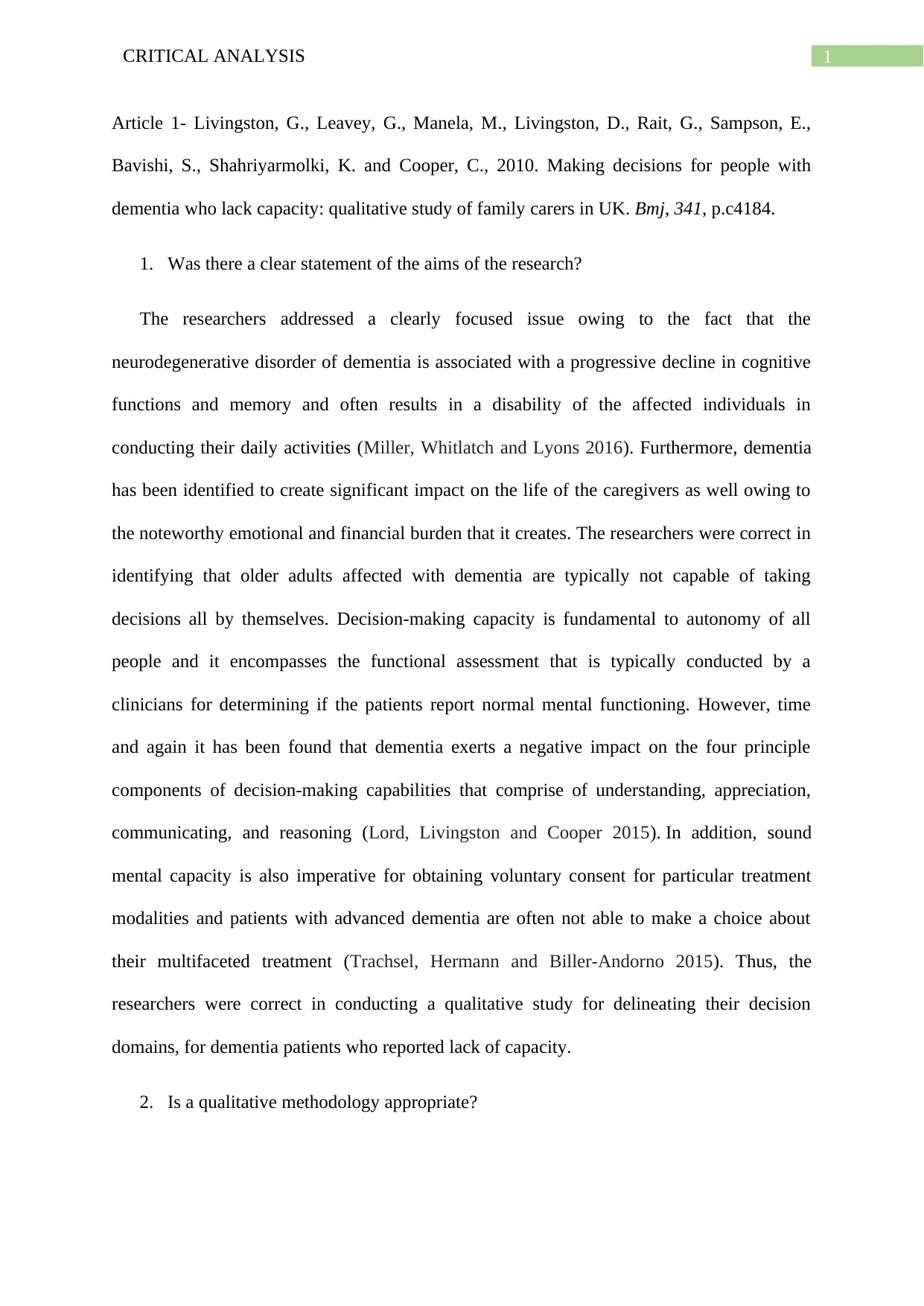
1CRITICAL ANALYSIS
Article 1- Livingston, G., Leavey, G., Manela, M., Livingston, D., Rait, G., Sampson, E.,
Bavishi, S., Shahriyarmolki, K. and Cooper, C., 2010. Making decisions for people with
dementia who lack capacity: qualitative study of family carers in UK. Bmj, 341, p.c4184.
1. Was there a clear statement of the aims of the research?
The researchers addressed a clearly focused issue owing to the fact that the
neurodegenerative disorder of dementia is associated with a progressive decline in cognitive
functions and memory and often results in a disability of the affected individuals in
conducting their daily activities (Miller, Whitlatch and Lyons 2016). Furthermore, dementia
has been identified to create significant impact on the life of the caregivers as well owing to
the noteworthy emotional and financial burden that it creates. The researchers were correct in
identifying that older adults affected with dementia are typically not capable of taking
decisions all by themselves. Decision-making capacity is fundamental to autonomy of all
people and it encompasses the functional assessment that is typically conducted by a
clinicians for determining if the patients report normal mental functioning. However, time
and again it has been found that dementia exerts a negative impact on the four principle
components of decision-making capabilities that comprise of understanding, appreciation,
communicating, and reasoning (Lord, Livingston and Cooper 2015). In addition, sound
mental capacity is also imperative for obtaining voluntary consent for particular treatment
modalities and patients with advanced dementia are often not able to make a choice about
their multifaceted treatment (Trachsel, Hermann and Biller-Andorno 2015). Thus, the
researchers were correct in conducting a qualitative study for delineating their decision
domains, for dementia patients who reported lack of capacity.
2. Is a qualitative methodology appropriate?
Article 1- Livingston, G., Leavey, G., Manela, M., Livingston, D., Rait, G., Sampson, E.,
Bavishi, S., Shahriyarmolki, K. and Cooper, C., 2010. Making decisions for people with
dementia who lack capacity: qualitative study of family carers in UK. Bmj, 341, p.c4184.
1. Was there a clear statement of the aims of the research?
The researchers addressed a clearly focused issue owing to the fact that the
neurodegenerative disorder of dementia is associated with a progressive decline in cognitive
functions and memory and often results in a disability of the affected individuals in
conducting their daily activities (Miller, Whitlatch and Lyons 2016). Furthermore, dementia
has been identified to create significant impact on the life of the caregivers as well owing to
the noteworthy emotional and financial burden that it creates. The researchers were correct in
identifying that older adults affected with dementia are typically not capable of taking
decisions all by themselves. Decision-making capacity is fundamental to autonomy of all
people and it encompasses the functional assessment that is typically conducted by a
clinicians for determining if the patients report normal mental functioning. However, time
and again it has been found that dementia exerts a negative impact on the four principle
components of decision-making capabilities that comprise of understanding, appreciation,
communicating, and reasoning (Lord, Livingston and Cooper 2015). In addition, sound
mental capacity is also imperative for obtaining voluntary consent for particular treatment
modalities and patients with advanced dementia are often not able to make a choice about
their multifaceted treatment (Trachsel, Hermann and Biller-Andorno 2015). Thus, the
researchers were correct in conducting a qualitative study for delineating their decision
domains, for dementia patients who reported lack of capacity.
2. Is a qualitative methodology appropriate?
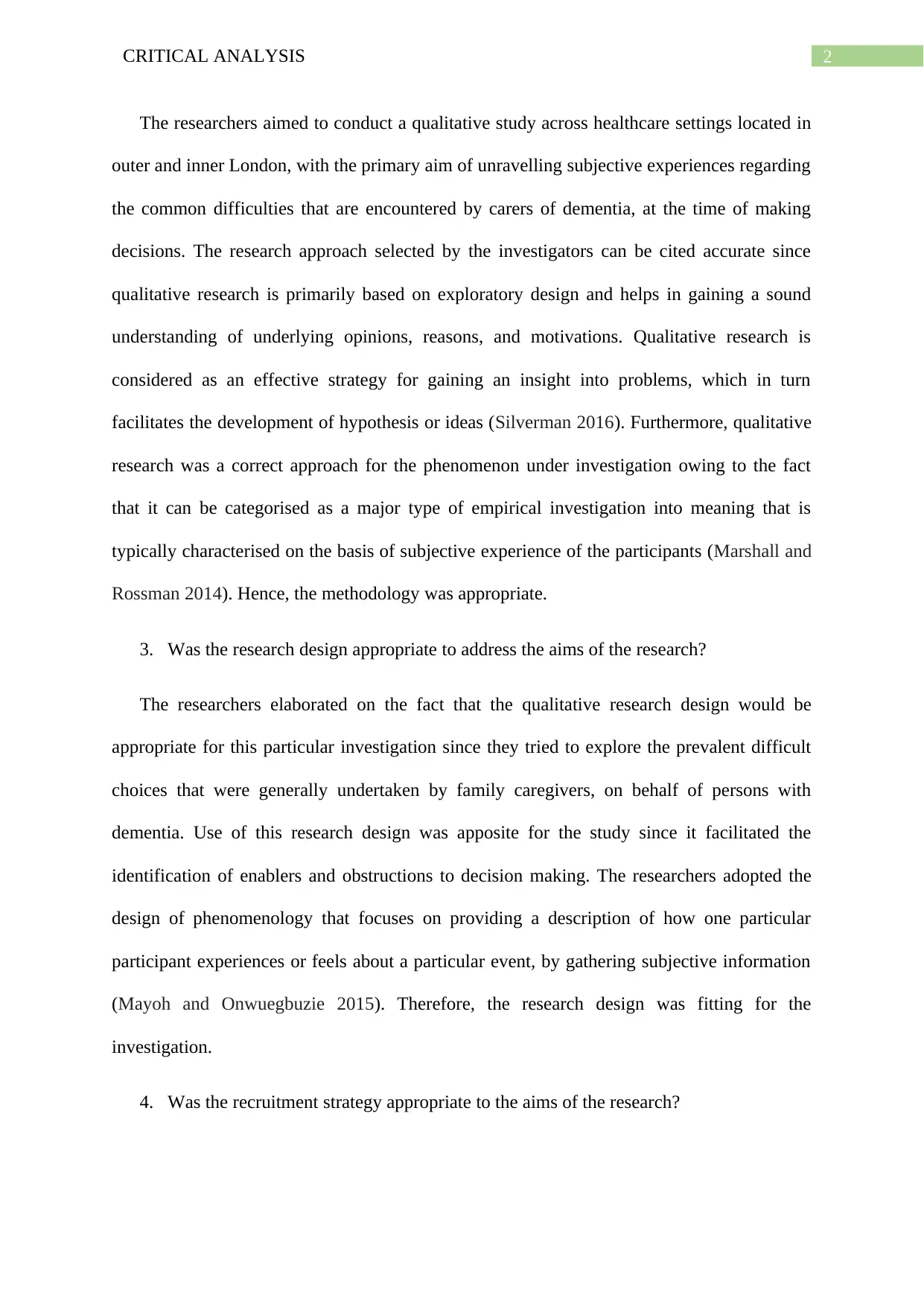
2CRITICAL ANALYSIS
The researchers aimed to conduct a qualitative study across healthcare settings located in
outer and inner London, with the primary aim of unravelling subjective experiences regarding
the common difficulties that are encountered by carers of dementia, at the time of making
decisions. The research approach selected by the investigators can be cited accurate since
qualitative research is primarily based on exploratory design and helps in gaining a sound
understanding of underlying opinions, reasons, and motivations. Qualitative research is
considered as an effective strategy for gaining an insight into problems, which in turn
facilitates the development of hypothesis or ideas (Silverman 2016). Furthermore, qualitative
research was a correct approach for the phenomenon under investigation owing to the fact
that it can be categorised as a major type of empirical investigation into meaning that is
typically characterised on the basis of subjective experience of the participants (Marshall and
Rossman 2014). Hence, the methodology was appropriate.
3. Was the research design appropriate to address the aims of the research?
The researchers elaborated on the fact that the qualitative research design would be
appropriate for this particular investigation since they tried to explore the prevalent difficult
choices that were generally undertaken by family caregivers, on behalf of persons with
dementia. Use of this research design was apposite for the study since it facilitated the
identification of enablers and obstructions to decision making. The researchers adopted the
design of phenomenology that focuses on providing a description of how one particular
participant experiences or feels about a particular event, by gathering subjective information
(Mayoh and Onwuegbuzie 2015). Therefore, the research design was fitting for the
investigation.
4. Was the recruitment strategy appropriate to the aims of the research?
The researchers aimed to conduct a qualitative study across healthcare settings located in
outer and inner London, with the primary aim of unravelling subjective experiences regarding
the common difficulties that are encountered by carers of dementia, at the time of making
decisions. The research approach selected by the investigators can be cited accurate since
qualitative research is primarily based on exploratory design and helps in gaining a sound
understanding of underlying opinions, reasons, and motivations. Qualitative research is
considered as an effective strategy for gaining an insight into problems, which in turn
facilitates the development of hypothesis or ideas (Silverman 2016). Furthermore, qualitative
research was a correct approach for the phenomenon under investigation owing to the fact
that it can be categorised as a major type of empirical investigation into meaning that is
typically characterised on the basis of subjective experience of the participants (Marshall and
Rossman 2014). Hence, the methodology was appropriate.
3. Was the research design appropriate to address the aims of the research?
The researchers elaborated on the fact that the qualitative research design would be
appropriate for this particular investigation since they tried to explore the prevalent difficult
choices that were generally undertaken by family caregivers, on behalf of persons with
dementia. Use of this research design was apposite for the study since it facilitated the
identification of enablers and obstructions to decision making. The researchers adopted the
design of phenomenology that focuses on providing a description of how one particular
participant experiences or feels about a particular event, by gathering subjective information
(Mayoh and Onwuegbuzie 2015). Therefore, the research design was fitting for the
investigation.
4. Was the recruitment strategy appropriate to the aims of the research?
⊘ This is a preview!⊘
Do you want full access?
Subscribe today to unlock all pages.

Trusted by 1+ million students worldwide
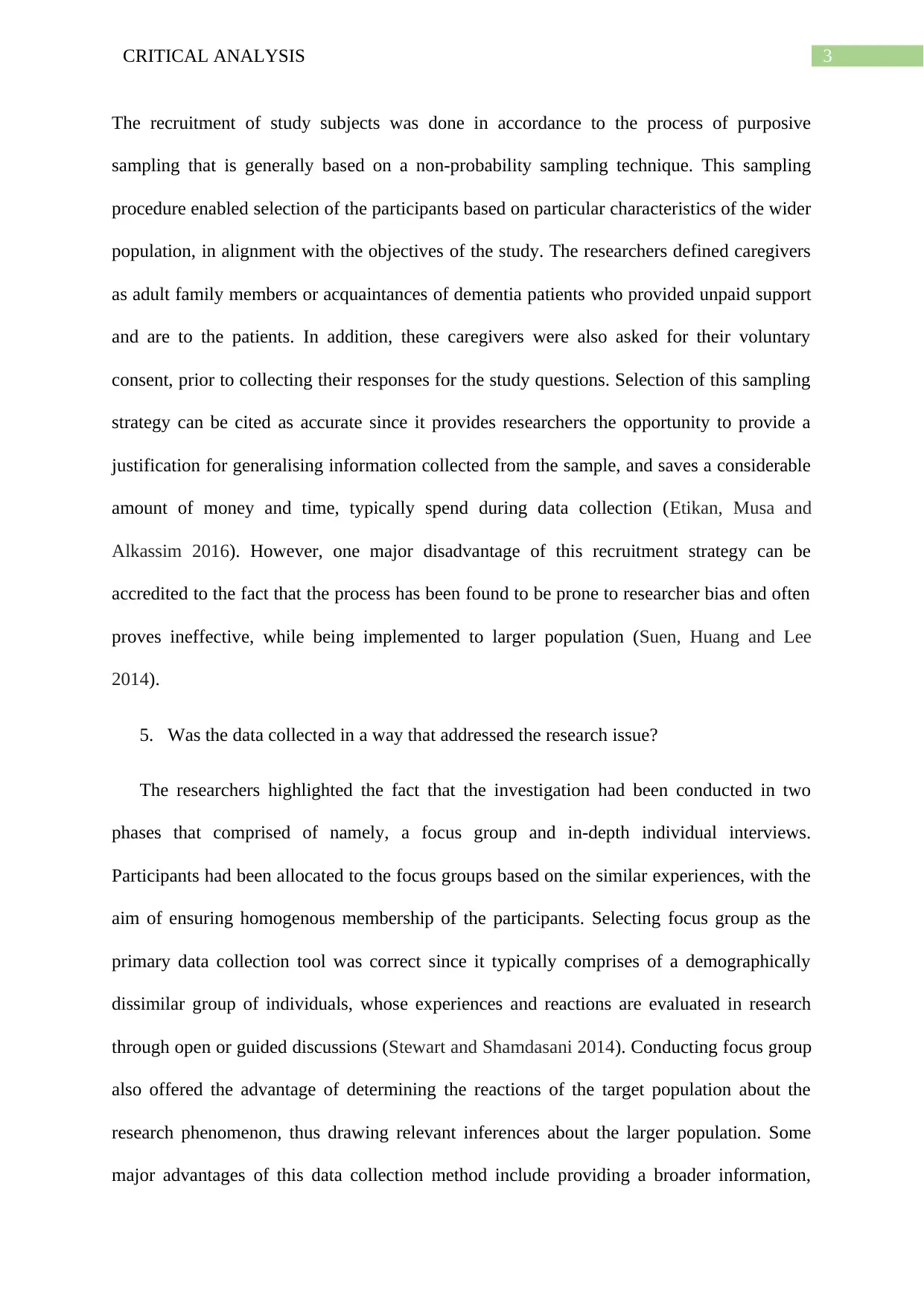
3CRITICAL ANALYSIS
The recruitment of study subjects was done in accordance to the process of purposive
sampling that is generally based on a non-probability sampling technique. This sampling
procedure enabled selection of the participants based on particular characteristics of the wider
population, in alignment with the objectives of the study. The researchers defined caregivers
as adult family members or acquaintances of dementia patients who provided unpaid support
and are to the patients. In addition, these caregivers were also asked for their voluntary
consent, prior to collecting their responses for the study questions. Selection of this sampling
strategy can be cited as accurate since it provides researchers the opportunity to provide a
justification for generalising information collected from the sample, and saves a considerable
amount of money and time, typically spend during data collection (Etikan, Musa and
Alkassim 2016). However, one major disadvantage of this recruitment strategy can be
accredited to the fact that the process has been found to be prone to researcher bias and often
proves ineffective, while being implemented to larger population (Suen, Huang and Lee
2014).
5. Was the data collected in a way that addressed the research issue?
The researchers highlighted the fact that the investigation had been conducted in two
phases that comprised of namely, a focus group and in-depth individual interviews.
Participants had been allocated to the focus groups based on the similar experiences, with the
aim of ensuring homogenous membership of the participants. Selecting focus group as the
primary data collection tool was correct since it typically comprises of a demographically
dissimilar group of individuals, whose experiences and reactions are evaluated in research
through open or guided discussions (Stewart and Shamdasani 2014). Conducting focus group
also offered the advantage of determining the reactions of the target population about the
research phenomenon, thus drawing relevant inferences about the larger population. Some
major advantages of this data collection method include providing a broader information,
The recruitment of study subjects was done in accordance to the process of purposive
sampling that is generally based on a non-probability sampling technique. This sampling
procedure enabled selection of the participants based on particular characteristics of the wider
population, in alignment with the objectives of the study. The researchers defined caregivers
as adult family members or acquaintances of dementia patients who provided unpaid support
and are to the patients. In addition, these caregivers were also asked for their voluntary
consent, prior to collecting their responses for the study questions. Selection of this sampling
strategy can be cited as accurate since it provides researchers the opportunity to provide a
justification for generalising information collected from the sample, and saves a considerable
amount of money and time, typically spend during data collection (Etikan, Musa and
Alkassim 2016). However, one major disadvantage of this recruitment strategy can be
accredited to the fact that the process has been found to be prone to researcher bias and often
proves ineffective, while being implemented to larger population (Suen, Huang and Lee
2014).
5. Was the data collected in a way that addressed the research issue?
The researchers highlighted the fact that the investigation had been conducted in two
phases that comprised of namely, a focus group and in-depth individual interviews.
Participants had been allocated to the focus groups based on the similar experiences, with the
aim of ensuring homogenous membership of the participants. Selecting focus group as the
primary data collection tool was correct since it typically comprises of a demographically
dissimilar group of individuals, whose experiences and reactions are evaluated in research
through open or guided discussions (Stewart and Shamdasani 2014). Conducting focus group
also offered the advantage of determining the reactions of the target population about the
research phenomenon, thus drawing relevant inferences about the larger population. Some
major advantages of this data collection method include providing a broader information,
Paraphrase This Document
Need a fresh take? Get an instant paraphrase of this document with our AI Paraphraser
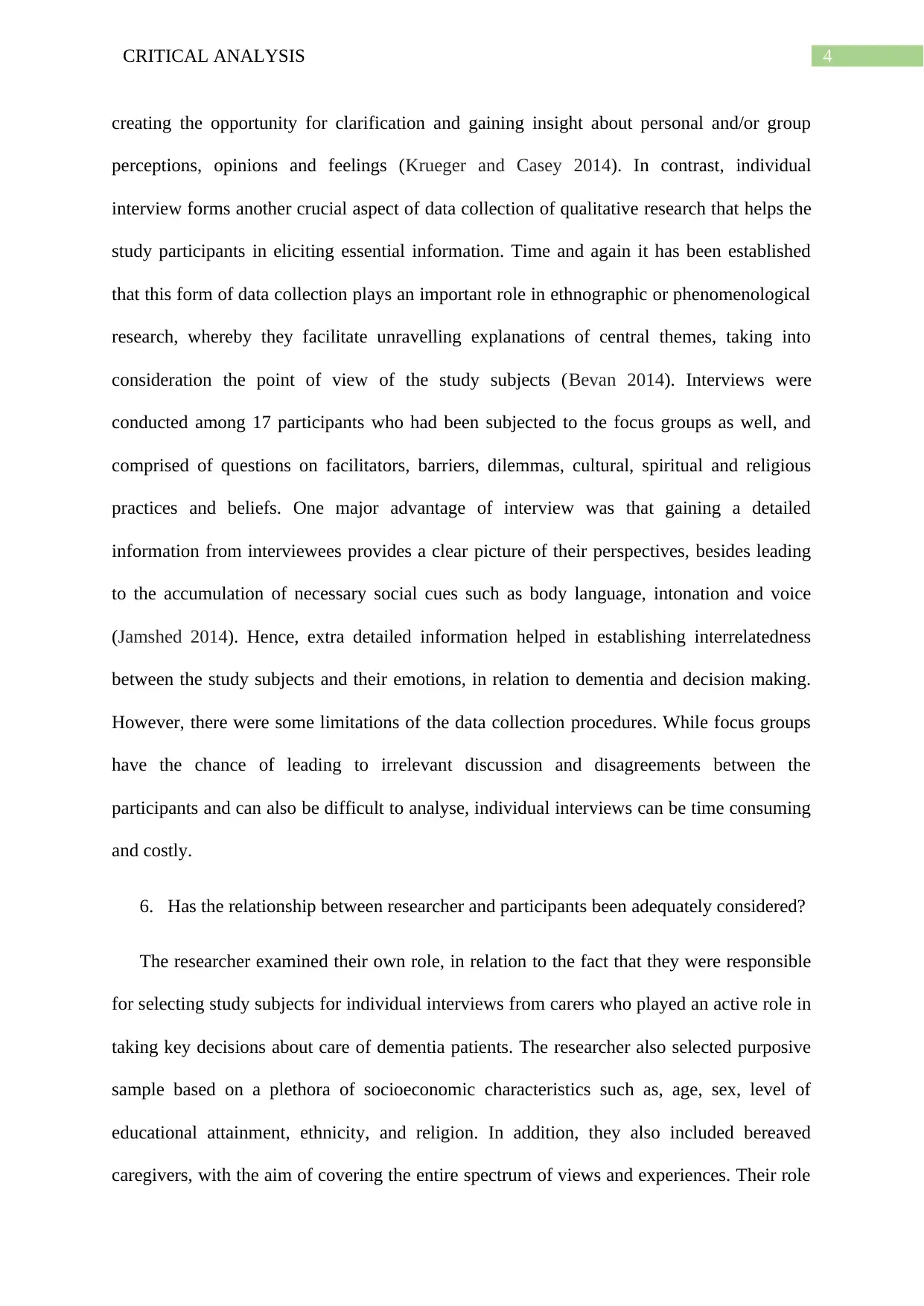
4CRITICAL ANALYSIS
creating the opportunity for clarification and gaining insight about personal and/or group
perceptions, opinions and feelings (Krueger and Casey 2014). In contrast, individual
interview forms another crucial aspect of data collection of qualitative research that helps the
study participants in eliciting essential information. Time and again it has been established
that this form of data collection plays an important role in ethnographic or phenomenological
research, whereby they facilitate unravelling explanations of central themes, taking into
consideration the point of view of the study subjects (Bevan 2014). Interviews were
conducted among 17 participants who had been subjected to the focus groups as well, and
comprised of questions on facilitators, barriers, dilemmas, cultural, spiritual and religious
practices and beliefs. One major advantage of interview was that gaining a detailed
information from interviewees provides a clear picture of their perspectives, besides leading
to the accumulation of necessary social cues such as body language, intonation and voice
(Jamshed 2014). Hence, extra detailed information helped in establishing interrelatedness
between the study subjects and their emotions, in relation to dementia and decision making.
However, there were some limitations of the data collection procedures. While focus groups
have the chance of leading to irrelevant discussion and disagreements between the
participants and can also be difficult to analyse, individual interviews can be time consuming
and costly.
6. Has the relationship between researcher and participants been adequately considered?
The researcher examined their own role, in relation to the fact that they were responsible
for selecting study subjects for individual interviews from carers who played an active role in
taking key decisions about care of dementia patients. The researcher also selected purposive
sample based on a plethora of socioeconomic characteristics such as, age, sex, level of
educational attainment, ethnicity, and religion. In addition, they also included bereaved
caregivers, with the aim of covering the entire spectrum of views and experiences. Their role
creating the opportunity for clarification and gaining insight about personal and/or group
perceptions, opinions and feelings (Krueger and Casey 2014). In contrast, individual
interview forms another crucial aspect of data collection of qualitative research that helps the
study participants in eliciting essential information. Time and again it has been established
that this form of data collection plays an important role in ethnographic or phenomenological
research, whereby they facilitate unravelling explanations of central themes, taking into
consideration the point of view of the study subjects (Bevan 2014). Interviews were
conducted among 17 participants who had been subjected to the focus groups as well, and
comprised of questions on facilitators, barriers, dilemmas, cultural, spiritual and religious
practices and beliefs. One major advantage of interview was that gaining a detailed
information from interviewees provides a clear picture of their perspectives, besides leading
to the accumulation of necessary social cues such as body language, intonation and voice
(Jamshed 2014). Hence, extra detailed information helped in establishing interrelatedness
between the study subjects and their emotions, in relation to dementia and decision making.
However, there were some limitations of the data collection procedures. While focus groups
have the chance of leading to irrelevant discussion and disagreements between the
participants and can also be difficult to analyse, individual interviews can be time consuming
and costly.
6. Has the relationship between researcher and participants been adequately considered?
The researcher examined their own role, in relation to the fact that they were responsible
for selecting study subjects for individual interviews from carers who played an active role in
taking key decisions about care of dementia patients. The researcher also selected purposive
sample based on a plethora of socioeconomic characteristics such as, age, sex, level of
educational attainment, ethnicity, and religion. In addition, they also included bereaved
caregivers, with the aim of covering the entire spectrum of views and experiences. Their role
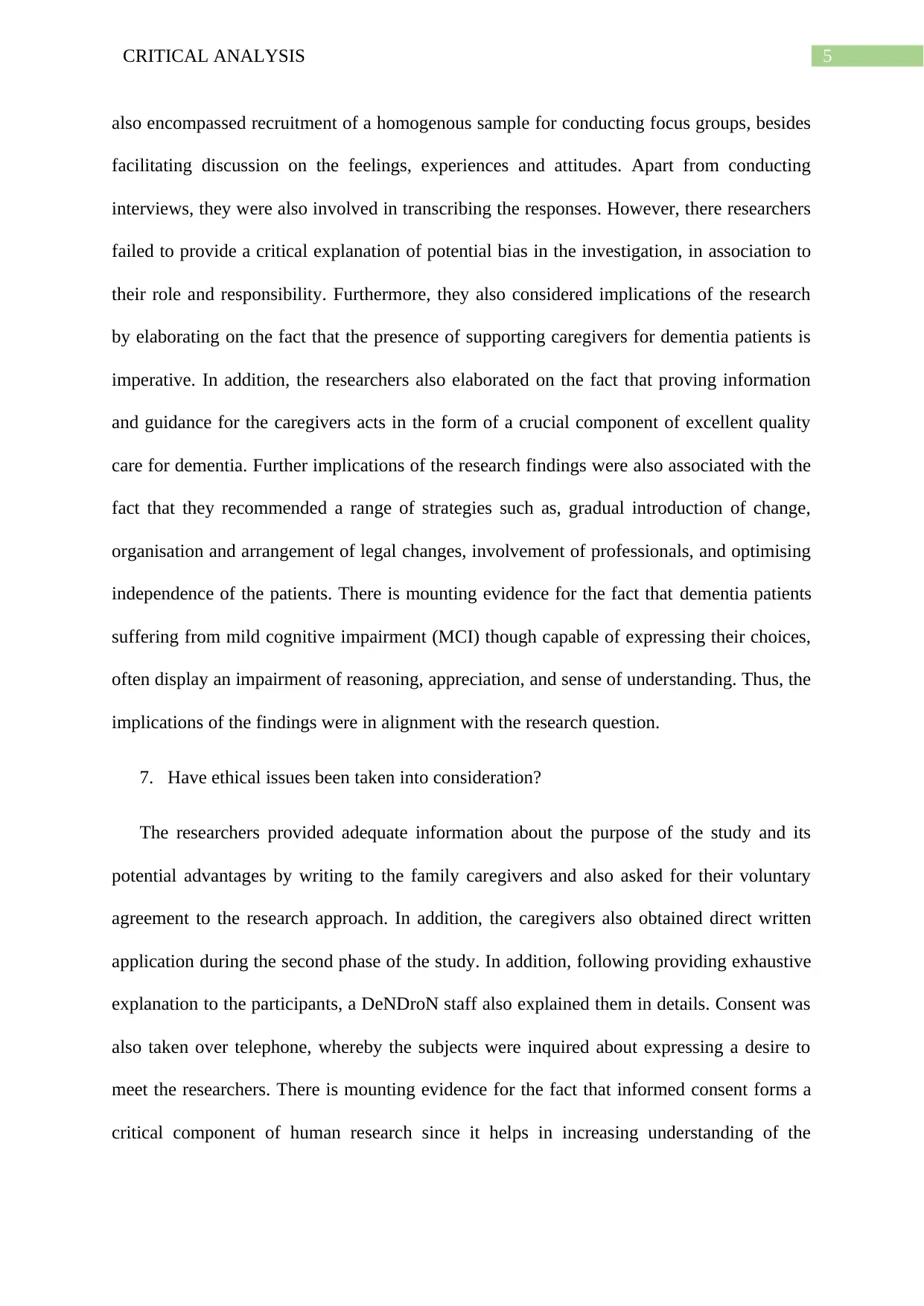
5CRITICAL ANALYSIS
also encompassed recruitment of a homogenous sample for conducting focus groups, besides
facilitating discussion on the feelings, experiences and attitudes. Apart from conducting
interviews, they were also involved in transcribing the responses. However, there researchers
failed to provide a critical explanation of potential bias in the investigation, in association to
their role and responsibility. Furthermore, they also considered implications of the research
by elaborating on the fact that the presence of supporting caregivers for dementia patients is
imperative. In addition, the researchers also elaborated on the fact that proving information
and guidance for the caregivers acts in the form of a crucial component of excellent quality
care for dementia. Further implications of the research findings were also associated with the
fact that they recommended a range of strategies such as, gradual introduction of change,
organisation and arrangement of legal changes, involvement of professionals, and optimising
independence of the patients. There is mounting evidence for the fact that dementia patients
suffering from mild cognitive impairment (MCI) though capable of expressing their choices,
often display an impairment of reasoning, appreciation, and sense of understanding. Thus, the
implications of the findings were in alignment with the research question.
7. Have ethical issues been taken into consideration?
The researchers provided adequate information about the purpose of the study and its
potential advantages by writing to the family caregivers and also asked for their voluntary
agreement to the research approach. In addition, the caregivers also obtained direct written
application during the second phase of the study. In addition, following providing exhaustive
explanation to the participants, a DeNDroN staff also explained them in details. Consent was
also taken over telephone, whereby the subjects were inquired about expressing a desire to
meet the researchers. There is mounting evidence for the fact that informed consent forms a
critical component of human research since it helps in increasing understanding of the
also encompassed recruitment of a homogenous sample for conducting focus groups, besides
facilitating discussion on the feelings, experiences and attitudes. Apart from conducting
interviews, they were also involved in transcribing the responses. However, there researchers
failed to provide a critical explanation of potential bias in the investigation, in association to
their role and responsibility. Furthermore, they also considered implications of the research
by elaborating on the fact that the presence of supporting caregivers for dementia patients is
imperative. In addition, the researchers also elaborated on the fact that proving information
and guidance for the caregivers acts in the form of a crucial component of excellent quality
care for dementia. Further implications of the research findings were also associated with the
fact that they recommended a range of strategies such as, gradual introduction of change,
organisation and arrangement of legal changes, involvement of professionals, and optimising
independence of the patients. There is mounting evidence for the fact that dementia patients
suffering from mild cognitive impairment (MCI) though capable of expressing their choices,
often display an impairment of reasoning, appreciation, and sense of understanding. Thus, the
implications of the findings were in alignment with the research question.
7. Have ethical issues been taken into consideration?
The researchers provided adequate information about the purpose of the study and its
potential advantages by writing to the family caregivers and also asked for their voluntary
agreement to the research approach. In addition, the caregivers also obtained direct written
application during the second phase of the study. In addition, following providing exhaustive
explanation to the participants, a DeNDroN staff also explained them in details. Consent was
also taken over telephone, whereby the subjects were inquired about expressing a desire to
meet the researchers. There is mounting evidence for the fact that informed consent forms a
critical component of human research since it helps in increasing understanding of the
⊘ This is a preview!⊘
Do you want full access?
Subscribe today to unlock all pages.

Trusted by 1+ million students worldwide
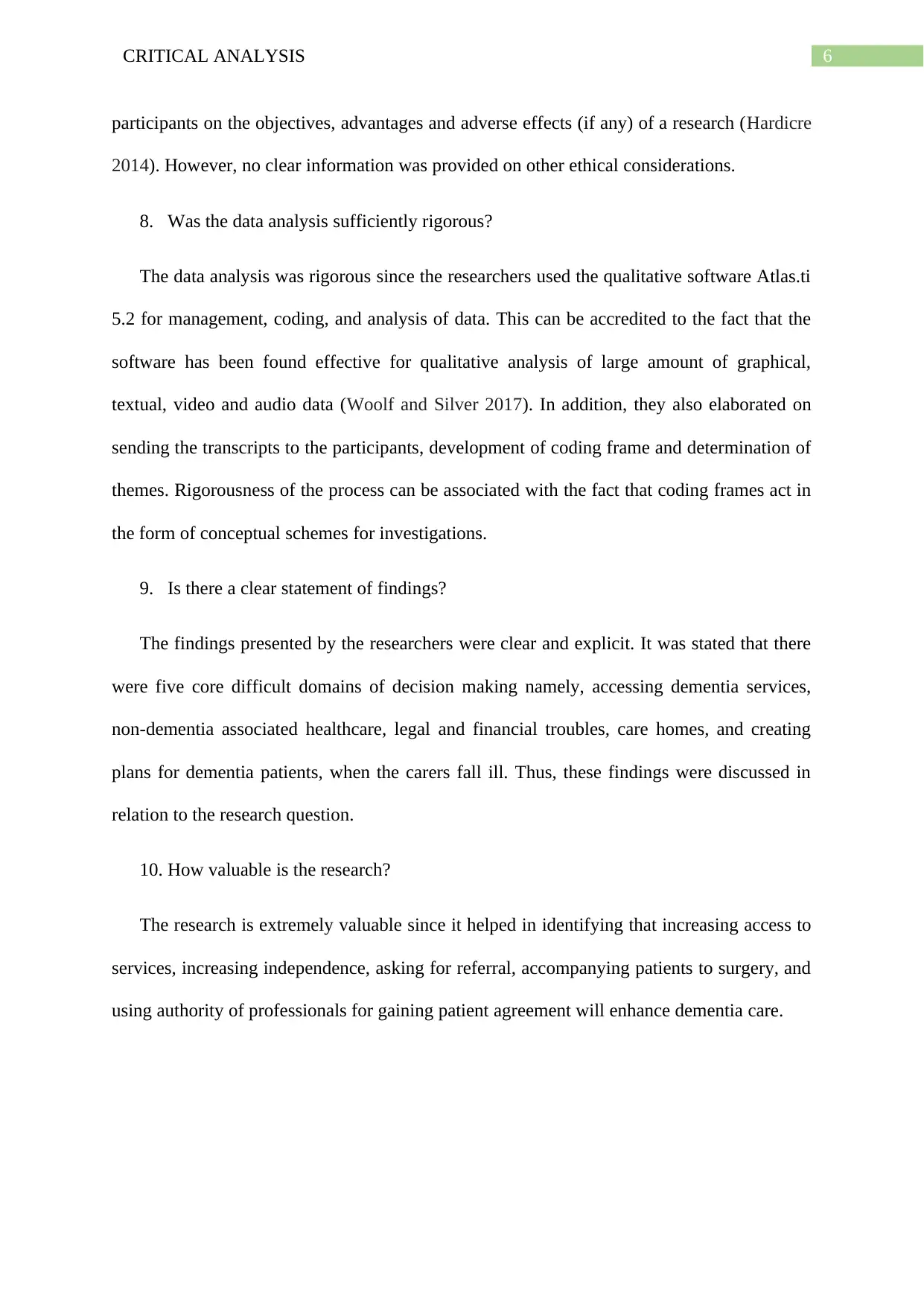
6CRITICAL ANALYSIS
participants on the objectives, advantages and adverse effects (if any) of a research (Hardicre
2014). However, no clear information was provided on other ethical considerations.
8. Was the data analysis sufficiently rigorous?
The data analysis was rigorous since the researchers used the qualitative software Atlas.ti
5.2 for management, coding, and analysis of data. This can be accredited to the fact that the
software has been found effective for qualitative analysis of large amount of graphical,
textual, video and audio data (Woolf and Silver 2017). In addition, they also elaborated on
sending the transcripts to the participants, development of coding frame and determination of
themes. Rigorousness of the process can be associated with the fact that coding frames act in
the form of conceptual schemes for investigations.
9. Is there a clear statement of findings?
The findings presented by the researchers were clear and explicit. It was stated that there
were five core difficult domains of decision making namely, accessing dementia services,
non-dementia associated healthcare, legal and financial troubles, care homes, and creating
plans for dementia patients, when the carers fall ill. Thus, these findings were discussed in
relation to the research question.
10. How valuable is the research?
The research is extremely valuable since it helped in identifying that increasing access to
services, increasing independence, asking for referral, accompanying patients to surgery, and
using authority of professionals for gaining patient agreement will enhance dementia care.
participants on the objectives, advantages and adverse effects (if any) of a research (Hardicre
2014). However, no clear information was provided on other ethical considerations.
8. Was the data analysis sufficiently rigorous?
The data analysis was rigorous since the researchers used the qualitative software Atlas.ti
5.2 for management, coding, and analysis of data. This can be accredited to the fact that the
software has been found effective for qualitative analysis of large amount of graphical,
textual, video and audio data (Woolf and Silver 2017). In addition, they also elaborated on
sending the transcripts to the participants, development of coding frame and determination of
themes. Rigorousness of the process can be associated with the fact that coding frames act in
the form of conceptual schemes for investigations.
9. Is there a clear statement of findings?
The findings presented by the researchers were clear and explicit. It was stated that there
were five core difficult domains of decision making namely, accessing dementia services,
non-dementia associated healthcare, legal and financial troubles, care homes, and creating
plans for dementia patients, when the carers fall ill. Thus, these findings were discussed in
relation to the research question.
10. How valuable is the research?
The research is extremely valuable since it helped in identifying that increasing access to
services, increasing independence, asking for referral, accompanying patients to surgery, and
using authority of professionals for gaining patient agreement will enhance dementia care.
Paraphrase This Document
Need a fresh take? Get an instant paraphrase of this document with our AI Paraphraser
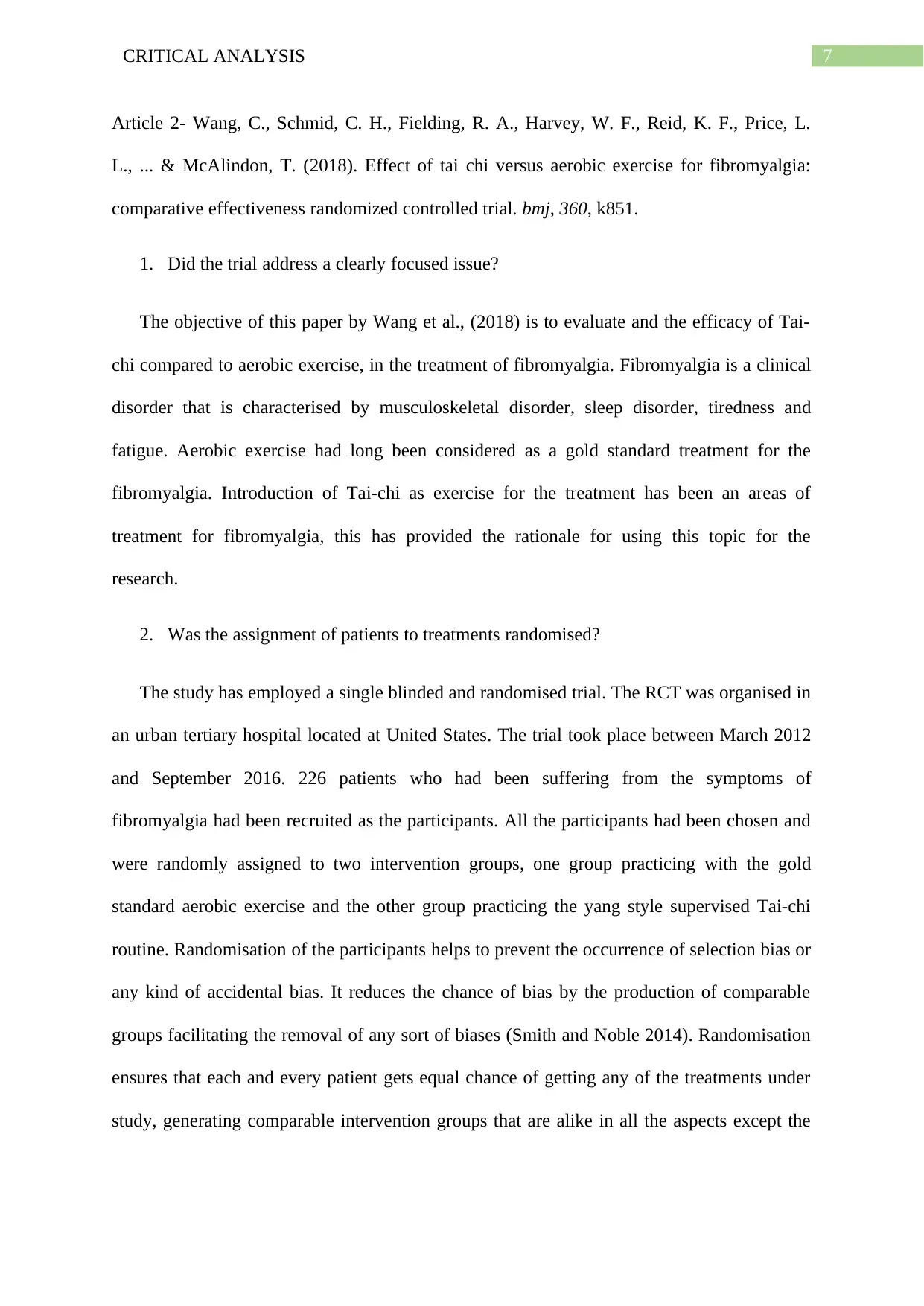
7CRITICAL ANALYSIS
Article 2- Wang, C., Schmid, C. H., Fielding, R. A., Harvey, W. F., Reid, K. F., Price, L.
L., ... & McAlindon, T. (2018). Effect of tai chi versus aerobic exercise for fibromyalgia:
comparative effectiveness randomized controlled trial. bmj, 360, k851.
1. Did the trial address a clearly focused issue?
The objective of this paper by Wang et al., (2018) is to evaluate and the efficacy of Tai-
chi compared to aerobic exercise, in the treatment of fibromyalgia. Fibromyalgia is a clinical
disorder that is characterised by musculoskeletal disorder, sleep disorder, tiredness and
fatigue. Aerobic exercise had long been considered as a gold standard treatment for the
fibromyalgia. Introduction of Tai-chi as exercise for the treatment has been an areas of
treatment for fibromyalgia, this has provided the rationale for using this topic for the
research.
2. Was the assignment of patients to treatments randomised?
The study has employed a single blinded and randomised trial. The RCT was organised in
an urban tertiary hospital located at United States. The trial took place between March 2012
and September 2016. 226 patients who had been suffering from the symptoms of
fibromyalgia had been recruited as the participants. All the participants had been chosen and
were randomly assigned to two intervention groups, one group practicing with the gold
standard aerobic exercise and the other group practicing the yang style supervised Tai-chi
routine. Randomisation of the participants helps to prevent the occurrence of selection bias or
any kind of accidental bias. It reduces the chance of bias by the production of comparable
groups facilitating the removal of any sort of biases (Smith and Noble 2014). Randomisation
ensures that each and every patient gets equal chance of getting any of the treatments under
study, generating comparable intervention groups that are alike in all the aspects except the
Article 2- Wang, C., Schmid, C. H., Fielding, R. A., Harvey, W. F., Reid, K. F., Price, L.
L., ... & McAlindon, T. (2018). Effect of tai chi versus aerobic exercise for fibromyalgia:
comparative effectiveness randomized controlled trial. bmj, 360, k851.
1. Did the trial address a clearly focused issue?
The objective of this paper by Wang et al., (2018) is to evaluate and the efficacy of Tai-
chi compared to aerobic exercise, in the treatment of fibromyalgia. Fibromyalgia is a clinical
disorder that is characterised by musculoskeletal disorder, sleep disorder, tiredness and
fatigue. Aerobic exercise had long been considered as a gold standard treatment for the
fibromyalgia. Introduction of Tai-chi as exercise for the treatment has been an areas of
treatment for fibromyalgia, this has provided the rationale for using this topic for the
research.
2. Was the assignment of patients to treatments randomised?
The study has employed a single blinded and randomised trial. The RCT was organised in
an urban tertiary hospital located at United States. The trial took place between March 2012
and September 2016. 226 patients who had been suffering from the symptoms of
fibromyalgia had been recruited as the participants. All the participants had been chosen and
were randomly assigned to two intervention groups, one group practicing with the gold
standard aerobic exercise and the other group practicing the yang style supervised Tai-chi
routine. Randomisation of the participants helps to prevent the occurrence of selection bias or
any kind of accidental bias. It reduces the chance of bias by the production of comparable
groups facilitating the removal of any sort of biases (Smith and Noble 2014). Randomisation
ensures that each and every patient gets equal chance of getting any of the treatments under
study, generating comparable intervention groups that are alike in all the aspects except the
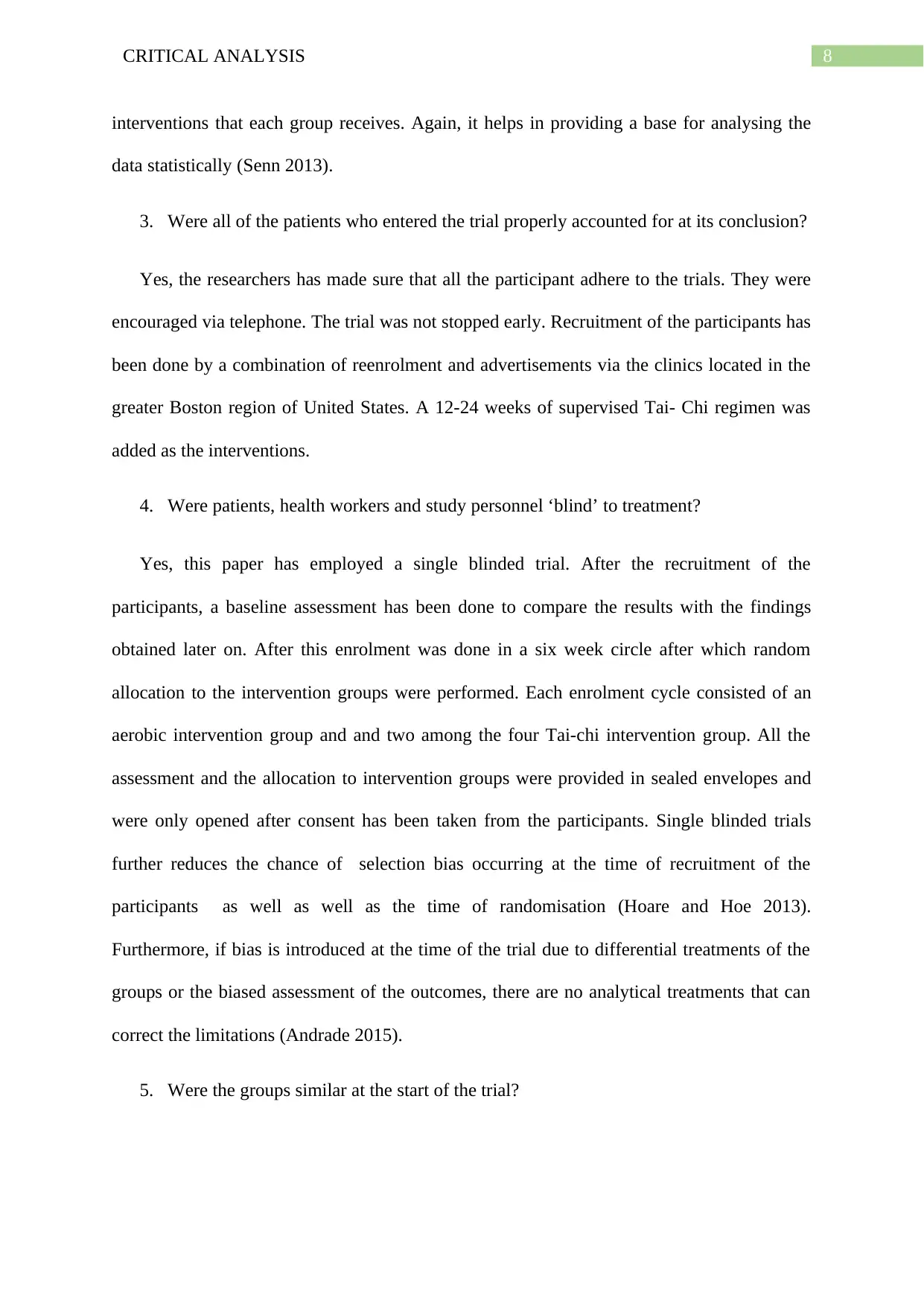
8CRITICAL ANALYSIS
interventions that each group receives. Again, it helps in providing a base for analysing the
data statistically (Senn 2013).
3. Were all of the patients who entered the trial properly accounted for at its conclusion?
Yes, the researchers has made sure that all the participant adhere to the trials. They were
encouraged via telephone. The trial was not stopped early. Recruitment of the participants has
been done by a combination of reenrolment and advertisements via the clinics located in the
greater Boston region of United States. A 12-24 weeks of supervised Tai- Chi regimen was
added as the interventions.
4. Were patients, health workers and study personnel ‘blind’ to treatment?
Yes, this paper has employed a single blinded trial. After the recruitment of the
participants, a baseline assessment has been done to compare the results with the findings
obtained later on. After this enrolment was done in a six week circle after which random
allocation to the intervention groups were performed. Each enrolment cycle consisted of an
aerobic intervention group and and two among the four Tai-chi intervention group. All the
assessment and the allocation to intervention groups were provided in sealed envelopes and
were only opened after consent has been taken from the participants. Single blinded trials
further reduces the chance of selection bias occurring at the time of recruitment of the
participants as well as well as the time of randomisation (Hoare and Hoe 2013).
Furthermore, if bias is introduced at the time of the trial due to differential treatments of the
groups or the biased assessment of the outcomes, there are no analytical treatments that can
correct the limitations (Andrade 2015).
5. Were the groups similar at the start of the trial?
interventions that each group receives. Again, it helps in providing a base for analysing the
data statistically (Senn 2013).
3. Were all of the patients who entered the trial properly accounted for at its conclusion?
Yes, the researchers has made sure that all the participant adhere to the trials. They were
encouraged via telephone. The trial was not stopped early. Recruitment of the participants has
been done by a combination of reenrolment and advertisements via the clinics located in the
greater Boston region of United States. A 12-24 weeks of supervised Tai- Chi regimen was
added as the interventions.
4. Were patients, health workers and study personnel ‘blind’ to treatment?
Yes, this paper has employed a single blinded trial. After the recruitment of the
participants, a baseline assessment has been done to compare the results with the findings
obtained later on. After this enrolment was done in a six week circle after which random
allocation to the intervention groups were performed. Each enrolment cycle consisted of an
aerobic intervention group and and two among the four Tai-chi intervention group. All the
assessment and the allocation to intervention groups were provided in sealed envelopes and
were only opened after consent has been taken from the participants. Single blinded trials
further reduces the chance of selection bias occurring at the time of recruitment of the
participants as well as well as the time of randomisation (Hoare and Hoe 2013).
Furthermore, if bias is introduced at the time of the trial due to differential treatments of the
groups or the biased assessment of the outcomes, there are no analytical treatments that can
correct the limitations (Andrade 2015).
5. Were the groups similar at the start of the trial?
⊘ This is a preview!⊘
Do you want full access?
Subscribe today to unlock all pages.

Trusted by 1+ million students worldwide
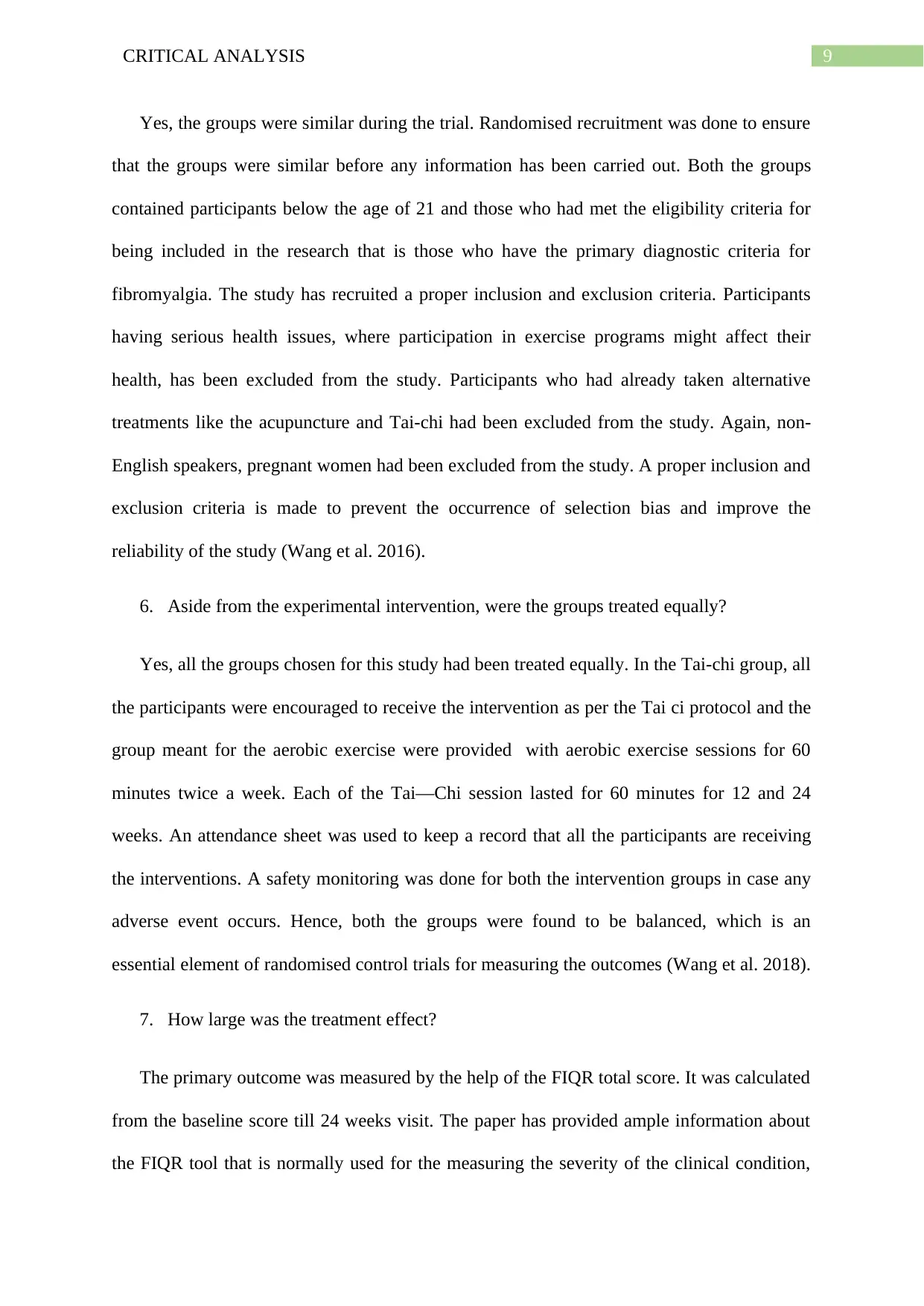
9CRITICAL ANALYSIS
Yes, the groups were similar during the trial. Randomised recruitment was done to ensure
that the groups were similar before any information has been carried out. Both the groups
contained participants below the age of 21 and those who had met the eligibility criteria for
being included in the research that is those who have the primary diagnostic criteria for
fibromyalgia. The study has recruited a proper inclusion and exclusion criteria. Participants
having serious health issues, where participation in exercise programs might affect their
health, has been excluded from the study. Participants who had already taken alternative
treatments like the acupuncture and Tai-chi had been excluded from the study. Again, non-
English speakers, pregnant women had been excluded from the study. A proper inclusion and
exclusion criteria is made to prevent the occurrence of selection bias and improve the
reliability of the study (Wang et al. 2016).
6. Aside from the experimental intervention, were the groups treated equally?
Yes, all the groups chosen for this study had been treated equally. In the Tai-chi group, all
the participants were encouraged to receive the intervention as per the Tai ci protocol and the
group meant for the aerobic exercise were provided with aerobic exercise sessions for 60
minutes twice a week. Each of the Tai—Chi session lasted for 60 minutes for 12 and 24
weeks. An attendance sheet was used to keep a record that all the participants are receiving
the interventions. A safety monitoring was done for both the intervention groups in case any
adverse event occurs. Hence, both the groups were found to be balanced, which is an
essential element of randomised control trials for measuring the outcomes (Wang et al. 2018).
7. How large was the treatment effect?
The primary outcome was measured by the help of the FIQR total score. It was calculated
from the baseline score till 24 weeks visit. The paper has provided ample information about
the FIQR tool that is normally used for the measuring the severity of the clinical condition,
Yes, the groups were similar during the trial. Randomised recruitment was done to ensure
that the groups were similar before any information has been carried out. Both the groups
contained participants below the age of 21 and those who had met the eligibility criteria for
being included in the research that is those who have the primary diagnostic criteria for
fibromyalgia. The study has recruited a proper inclusion and exclusion criteria. Participants
having serious health issues, where participation in exercise programs might affect their
health, has been excluded from the study. Participants who had already taken alternative
treatments like the acupuncture and Tai-chi had been excluded from the study. Again, non-
English speakers, pregnant women had been excluded from the study. A proper inclusion and
exclusion criteria is made to prevent the occurrence of selection bias and improve the
reliability of the study (Wang et al. 2016).
6. Aside from the experimental intervention, were the groups treated equally?
Yes, all the groups chosen for this study had been treated equally. In the Tai-chi group, all
the participants were encouraged to receive the intervention as per the Tai ci protocol and the
group meant for the aerobic exercise were provided with aerobic exercise sessions for 60
minutes twice a week. Each of the Tai—Chi session lasted for 60 minutes for 12 and 24
weeks. An attendance sheet was used to keep a record that all the participants are receiving
the interventions. A safety monitoring was done for both the intervention groups in case any
adverse event occurs. Hence, both the groups were found to be balanced, which is an
essential element of randomised control trials for measuring the outcomes (Wang et al. 2018).
7. How large was the treatment effect?
The primary outcome was measured by the help of the FIQR total score. It was calculated
from the baseline score till 24 weeks visit. The paper has provided ample information about
the FIQR tool that is normally used for the measuring the severity of the clinical condition,
Paraphrase This Document
Need a fresh take? Get an instant paraphrase of this document with our AI Paraphraser
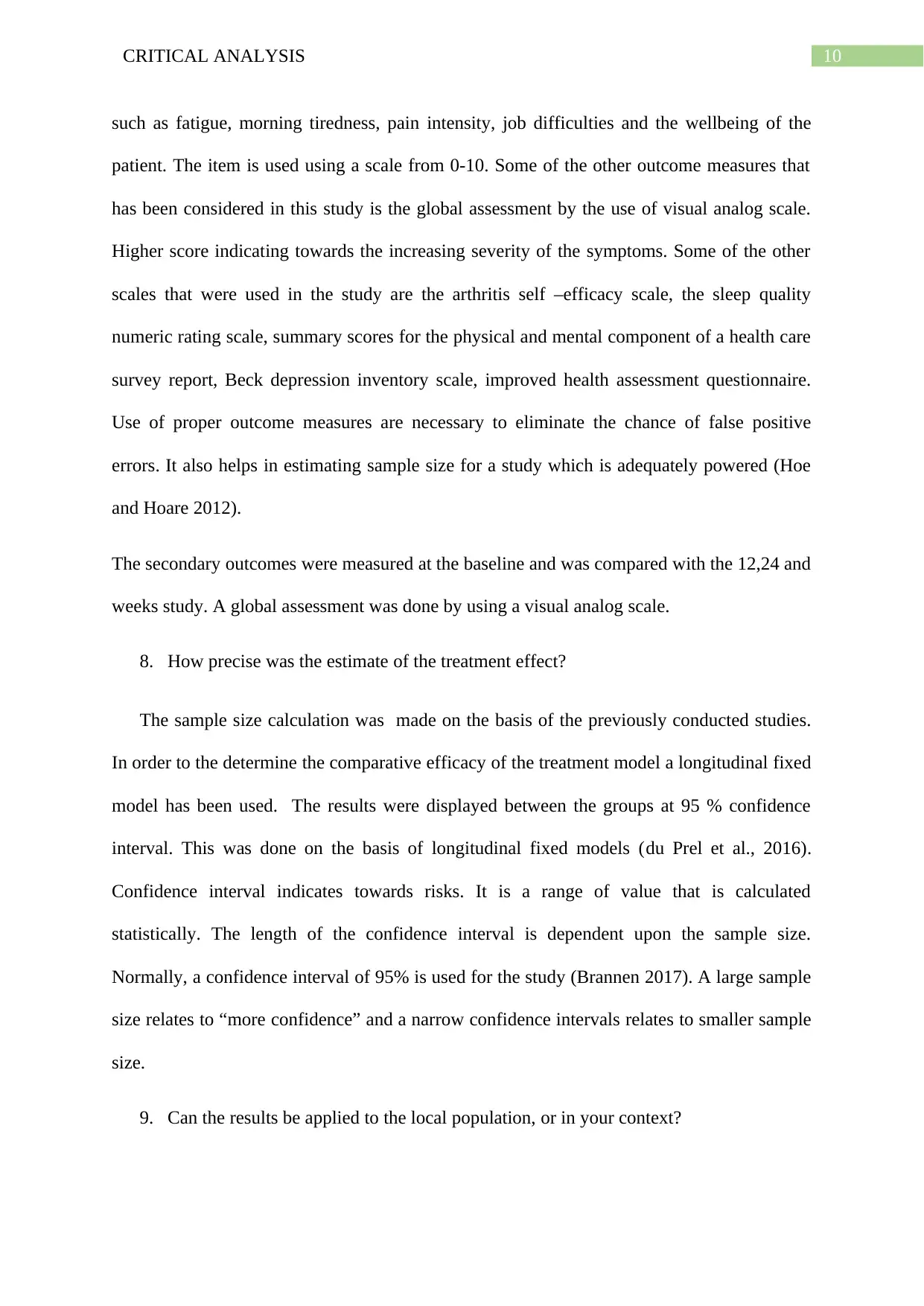
10CRITICAL ANALYSIS
such as fatigue, morning tiredness, pain intensity, job difficulties and the wellbeing of the
patient. The item is used using a scale from 0-10. Some of the other outcome measures that
has been considered in this study is the global assessment by the use of visual analog scale.
Higher score indicating towards the increasing severity of the symptoms. Some of the other
scales that were used in the study are the arthritis self –efficacy scale, the sleep quality
numeric rating scale, summary scores for the physical and mental component of a health care
survey report, Beck depression inventory scale, improved health assessment questionnaire.
Use of proper outcome measures are necessary to eliminate the chance of false positive
errors. It also helps in estimating sample size for a study which is adequately powered (Hoe
and Hoare 2012).
The secondary outcomes were measured at the baseline and was compared with the 12,24 and
weeks study. A global assessment was done by using a visual analog scale.
8. How precise was the estimate of the treatment effect?
The sample size calculation was made on the basis of the previously conducted studies.
In order to the determine the comparative efficacy of the treatment model a longitudinal fixed
model has been used. The results were displayed between the groups at 95 % confidence
interval. This was done on the basis of longitudinal fixed models (du Prel et al., 2016).
Confidence interval indicates towards risks. It is a range of value that is calculated
statistically. The length of the confidence interval is dependent upon the sample size.
Normally, a confidence interval of 95% is used for the study (Brannen 2017). A large sample
size relates to “more confidence” and a narrow confidence intervals relates to smaller sample
size.
9. Can the results be applied to the local population, or in your context?
such as fatigue, morning tiredness, pain intensity, job difficulties and the wellbeing of the
patient. The item is used using a scale from 0-10. Some of the other outcome measures that
has been considered in this study is the global assessment by the use of visual analog scale.
Higher score indicating towards the increasing severity of the symptoms. Some of the other
scales that were used in the study are the arthritis self –efficacy scale, the sleep quality
numeric rating scale, summary scores for the physical and mental component of a health care
survey report, Beck depression inventory scale, improved health assessment questionnaire.
Use of proper outcome measures are necessary to eliminate the chance of false positive
errors. It also helps in estimating sample size for a study which is adequately powered (Hoe
and Hoare 2012).
The secondary outcomes were measured at the baseline and was compared with the 12,24 and
weeks study. A global assessment was done by using a visual analog scale.
8. How precise was the estimate of the treatment effect?
The sample size calculation was made on the basis of the previously conducted studies.
In order to the determine the comparative efficacy of the treatment model a longitudinal fixed
model has been used. The results were displayed between the groups at 95 % confidence
interval. This was done on the basis of longitudinal fixed models (du Prel et al., 2016).
Confidence interval indicates towards risks. It is a range of value that is calculated
statistically. The length of the confidence interval is dependent upon the sample size.
Normally, a confidence interval of 95% is used for the study (Brannen 2017). A large sample
size relates to “more confidence” and a narrow confidence intervals relates to smaller sample
size.
9. Can the results be applied to the local population, or in your context?
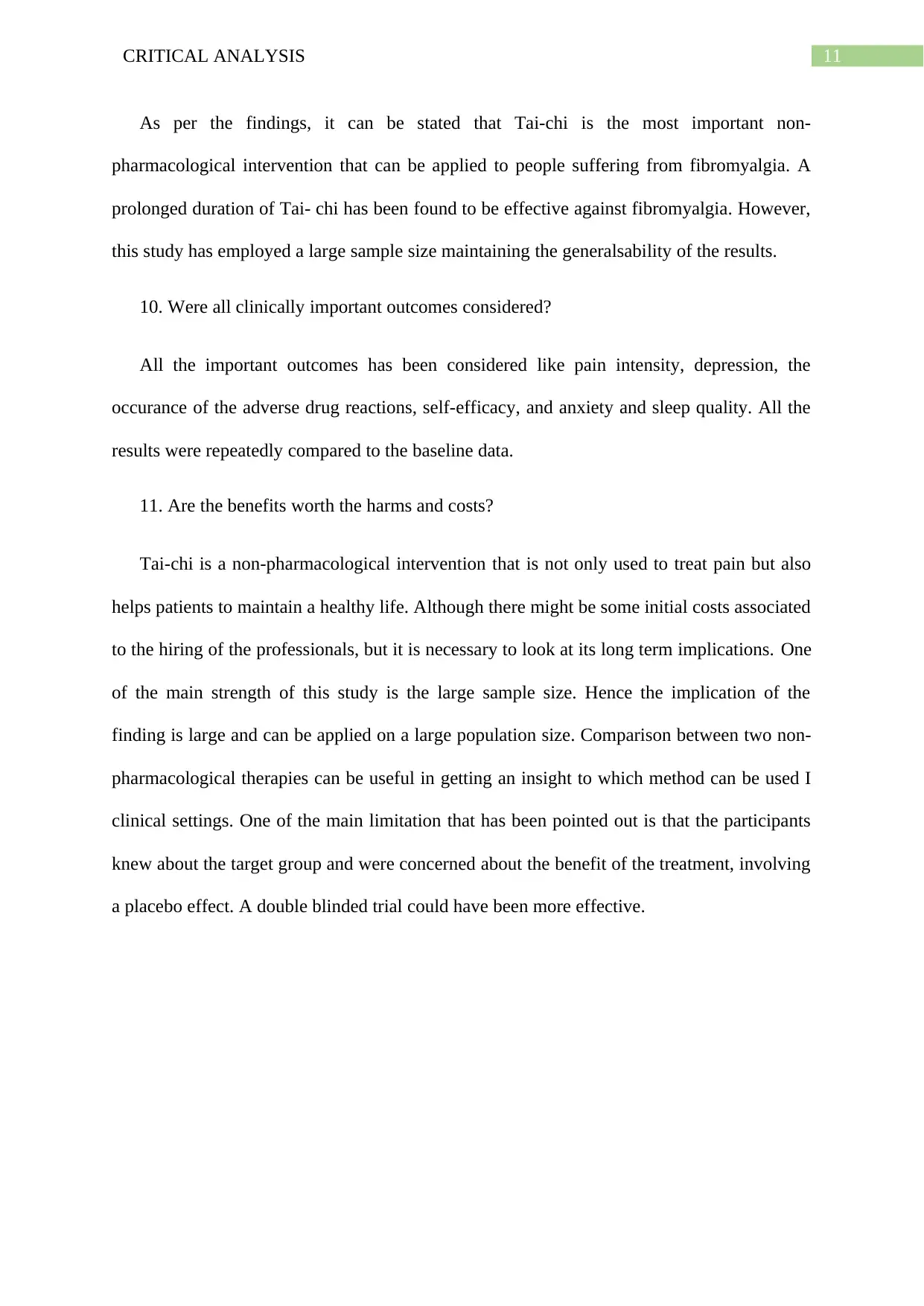
11CRITICAL ANALYSIS
As per the findings, it can be stated that Tai-chi is the most important non-
pharmacological intervention that can be applied to people suffering from fibromyalgia. A
prolonged duration of Tai- chi has been found to be effective against fibromyalgia. However,
this study has employed a large sample size maintaining the generalsability of the results.
10. Were all clinically important outcomes considered?
All the important outcomes has been considered like pain intensity, depression, the
occurance of the adverse drug reactions, self-efficacy, and anxiety and sleep quality. All the
results were repeatedly compared to the baseline data.
11. Are the benefits worth the harms and costs?
Tai-chi is a non-pharmacological intervention that is not only used to treat pain but also
helps patients to maintain a healthy life. Although there might be some initial costs associated
to the hiring of the professionals, but it is necessary to look at its long term implications. One
of the main strength of this study is the large sample size. Hence the implication of the
finding is large and can be applied on a large population size. Comparison between two non-
pharmacological therapies can be useful in getting an insight to which method can be used I
clinical settings. One of the main limitation that has been pointed out is that the participants
knew about the target group and were concerned about the benefit of the treatment, involving
a placebo effect. A double blinded trial could have been more effective.
As per the findings, it can be stated that Tai-chi is the most important non-
pharmacological intervention that can be applied to people suffering from fibromyalgia. A
prolonged duration of Tai- chi has been found to be effective against fibromyalgia. However,
this study has employed a large sample size maintaining the generalsability of the results.
10. Were all clinically important outcomes considered?
All the important outcomes has been considered like pain intensity, depression, the
occurance of the adverse drug reactions, self-efficacy, and anxiety and sleep quality. All the
results were repeatedly compared to the baseline data.
11. Are the benefits worth the harms and costs?
Tai-chi is a non-pharmacological intervention that is not only used to treat pain but also
helps patients to maintain a healthy life. Although there might be some initial costs associated
to the hiring of the professionals, but it is necessary to look at its long term implications. One
of the main strength of this study is the large sample size. Hence the implication of the
finding is large and can be applied on a large population size. Comparison between two non-
pharmacological therapies can be useful in getting an insight to which method can be used I
clinical settings. One of the main limitation that has been pointed out is that the participants
knew about the target group and were concerned about the benefit of the treatment, involving
a placebo effect. A double blinded trial could have been more effective.
⊘ This is a preview!⊘
Do you want full access?
Subscribe today to unlock all pages.

Trusted by 1+ million students worldwide
1 out of 15
Related Documents
Your All-in-One AI-Powered Toolkit for Academic Success.
+13062052269
info@desklib.com
Available 24*7 on WhatsApp / Email
![[object Object]](/_next/static/media/star-bottom.7253800d.svg)
Unlock your academic potential
Copyright © 2020–2025 A2Z Services. All Rights Reserved. Developed and managed by ZUCOL.





